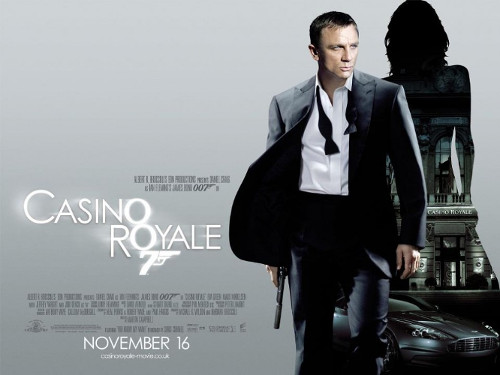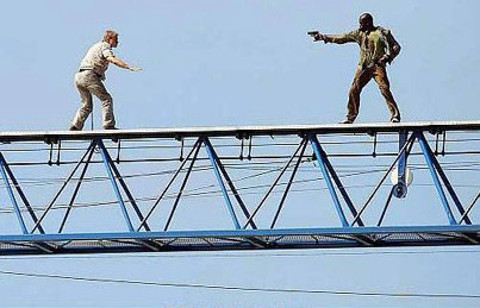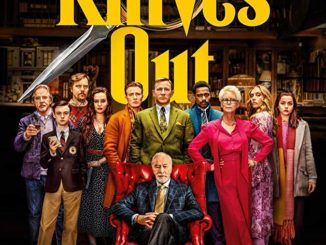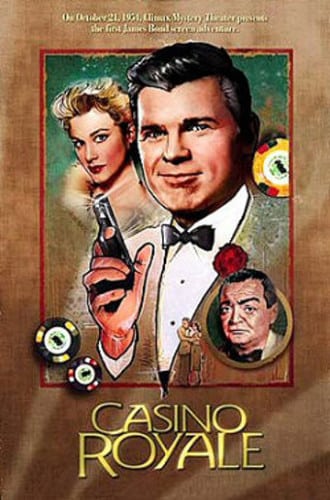Casino Royale (2006)
Directed by: Martin Campbell
Written by: Ian Fleming, Neal Purvis, Paul Haggis, Robert Wade
Starring: Daniel Craig, Eva Green, Jefrrey Wright, Mads Mikkelsen
UK
AVAILABLE ON BLU-RAY AND DVD
RUNNING TIME: 144 mins
REVIEWED BY: Dr Lenera, Official HCF Critic
James Bond has just earned his licence to kill, but is told off by M for having violated international law when his pursuit of bomb maker Mollaka in Madagascar results in him blowing up an African embassy, and advised to rethink his future as an agent. Clues from Mollaka point to corrupt Greek official Alex Dimitrios whom Bond follows from the Bahamas to Miami and kills, in the process thwarting the destruction of a Skyfleet plane. Terrorist financier Le Chiffre had bet money on the company’s failure, so to recoup the money he sets up a high-stakes Texas hold ’em tournament at the Casino Royale in Montenegro. MI6 enters Bond in the tournament, believing that a defeat will force Le Chiffre to seek asylum with the British government, which they will grant in exchange for information on his clients.…
When I saw it at the cinema, I distinctly remember thinking that Casino Royale, while being the best Bond film since The Living Daylights and maybe even since the 1960’s, would have a harder time at the box office then most other Bonds, with its stripped down, ‘back to basics’ approach, its serious tone, its often leisurely pacing, it having fewer major action sequences than normal, its considerable length, and with a star who’d attracted an extraordinary amount of hatred because he didn’t seem to fit some people’s opinion of what James Bond should look like. I honestly thought that Craig would do a George Lazenby and the producers would tempt Pierce Brosnan back for one more or at least rethink things. But I was happy to be proved wrong, the majority of folk very curious about this new 007 and really taking to what felt like a breath of fresh air in 2006. Yes, I enjoyed The World Is Not Enough and even Die Another Day more then many as my reviews of those two films make evident, but as a fan of the Bond books as well as the films I was thrilled to see Ian Fleming’s world back on the screen in a way that hadn’t been attempted since On Her Majesty’s Secret Service [and the similarities between that film and this one are many]. It does have a few faults, particularly the way it front loads much of the exciting bits, and its middle section devoting far too much time to a game of Texas hold ’em [a variant on poker] which the majority of viewers won’t understand. But by and large, they succeeded against the odds in successfully rebooting Bond for what seemed to be a more cynical, more serious and more dangerous world.
Eon Productions gained the rights in 1999 after Sony Pictures Entertainment exchanged them for MGM’s rights to Spider-Man. Quentin Tarantino expressed interest in writing and directing Brosnan in a very faithful adaptation set in the 1960’s, but Neal Purvis and Robert Wade wrote the script, to which Paul Haggis made some amendments, notably giving Vesper Lynd a more dramatic end. The intention was to use SPECTRE, but that periodical nuisance Kevin McClory still claimed the rights to Blofeld and his organisation. Brosnan eventually stepped down, and Karl Urban, Henry Cavill, Sam Worthington and Dougray Scott were considered and Hugh Jackman turned the part down due to other commitments before Craig was cast. As for Vesper, Angelina Jolie, Naomi Watts, Scarlett Johansson, Charlize Theron and Audrey Tautou was all considered. Location filming took place in Prague, Loket in the Czech Republic [doubling for Montenegro], The Bahamas, Venice and Lambardio in Italy, with interior sets built at Barrandov Studios, Prague and Pinewood Studios, where the sinking of the Venetian house at the climax featured the largest rig ever built for a Bond film. Craig lost his two front teeth while filming the stairwell fight scene in Prague and his dentist had to fly from London to replace them. One week after filming, the 007 Stage at Pinewood burned down, the second time this had happened. The UK version lost ten seconds from the torture scene while the US one suffered cuts to two fight scenes. Eventually the full version came out in the UK on Blu-ray but only in a box set with other Bond films, though it’s available from most other European countries.
For the first time in the series we have a scene in black and white, with even the MGM and Columbia logos in monochrome. Bond surprises a traitorous MI6 chief in his house who tells him that has no kills and is corrected with a slightly blurry flashback to a brutal struggle in a bathroom where Bond, having been ordered to kill for the first time, really struggles to complete his task. “You needn’t worry, the second is easier” says Bond as he shoots at the audience and up comes the gun barrel, which is maybe one revision too many, it really belongs at the very beginning. Once again Daniel Kleinman comes up with some great titles, inspired by the cover of the 1953 first edition of the novel, representing cards and the tribulations of Bond’s love story in the film, with guns firing clubs and slashed arteries spurting thousands of tiny hearts. And it’s nice to have a more rock-style theme song, Chris Cornell and David Arnold’s You Know My Name – not a great one but good enough to make one briefly forget that Madonna crap. In Uganda, the mysterious Mr. White introduces warlord Steven Obanno of to Le Chiffre, a terrorist financier. Obanno entrusts Le Chiffre with a large sum of money to invest safely for him, but instead Le Chiffre uses it to buy put options on the aerospace company Skyfleet, thus betting the money on the company’s failure. These villains do seem to exist mainly in the real world, though it’s a shame that they still had to give Le Chiffre a bleeding eye. The film’s best action scene is next and the free-running chase up a crane, onto another crane, down it, through a building site and into an embassy is quite something; spectacular, thrilling, and it’s interesting to see Bond make mistakes. Unfortunately nothing else in the film comes close to matching it even when Bond tries to prevent a bomb going off in Miami airport and engages in a fight in a truck similar to the one in Raiders Of The Lost Ark. Just before that, we see him seduce a woman for information but not actually sleep with her. He’s not quite the cold-hearted user of women yet though dialogue indicates that he could be on his way.
Just over a third of the way through, Casino Royale basically ‘becomes’ the novel which would have probably been too short to stretch out into a film, though the early scene in the film where Bond beats an opponent at poker, and wins the keys to his Aston Martin, is actually from the novel of Goldfinger. The central card game is broken up so we get to enjoy an incredible fight down several flights of stairs and a truly tense bit involving Bond being poisoned – giving him a heart attack – and a convenient defibrillator stored in his new Aston Martin. The game manages to not be exactly boring, David Arnold really helping to provide some tension with his music, but it’s just far too long considering that most of us don’t know the rules. Fleming was able to describe baccarat [not sure why the movie changed it] in quite a few pages so the reader was then involved in the game which makes for suspenseful reading, but I guess the film couldn’t do this. Bond wins the game but he soon finds himself being tortured for the third film running in the series. The book’s carpet beater is changed to a knotted rope and we’re spared the sight of Le Chiffre cutting Bond’s back so he bleeds on the floor and rats are released in a feeding frenzy underneath the chair. But even in cut form [the most substantial bit removed from the UK version was a suggestion of homosexuality from Le Chiffre], it’s still the nastiest scene in any 007 film despite Bond’s use of humour to get him through it, Craig being especially good here. And one wonders how he’s able to have sex so quickly afterwards considering the state of his balls. O well, it’s still Bond.
The woman in question is treasury agent Vesper Lynd, and we go through the painful process of seeing Bond love and lose again for the second time in the series. Vesper’s transformation from frosty to friendly is a little sudden, but then she says that she’s a complicated woman which is good enough for me as I’ve certainly been there. I love this vulnerable bit of dialogue from Bond: “I have no armour left. You’ve stripped it from me. Whatever is left of me – whatever is left of me – whatever I am – I’m yours”. While there are a few well placed chuckles like Bond saying: “Do I look like I give a damn”? in response to a barman asking how he wants his martini, the script mostly [a few bits remain] avoids the usual Purvis and Wade crassness which means that we’re able to really feel the tragedy of a main character who has to essentially lose much of his humanity to become the “blunt instrument” wielded by MI5 and with whom we’re familiar. While the sinking house finale is a little disappointing, it shows with clarity a much more efficient Bond than we saw earlier, and one feels like almost cheering when the last scene shows him turning up at Mr. White’s house with a bloody great machine gun as we hear a full version of the James Bond theme for the first time. But we’re also asked to consider what has been lost. Craig is note perfect throughout, he’s even asked to be really happy, the happiest we’ve ever seen Bond, during his later scenes with Vesper, which makes the revelation of her character and her fate all the more sad. While I still prefer Sean Connery, there’s no doubt that Craig embodies, far more than even Timothy Dalton, the Bond that Fleming wrote about, and in contrast with many I thought he looked the part immediately, his build convincing me that at last here was a Bond who really could convincingly beat up several opponents at once, and his piercing blue eyes seemed those of a killer – yet he could still be suave or charming when he needs to be.
What with no Moneypenny and no ‘Q’, it’s down to Judi Dench as ‘M’ to carry the MI6 side and her scenes with Craig bristle with tension and a grudging respect. Bond does get some assistance from a new Felix Leiter in the form of Jeffrey Wright who’s okay in the part, while Giancarlo Giannini as René Mathis Bond’s contact in Montenegro reminds me on Moonraker’s Michael Lonsdale. The other main lady in the film is Caterina Murino as Solange Dimitrios who becomes the obligatory sacrificial lamb. Looks over acting ability sums her up. Action editing is even more slam bang then before but you can still see what’s going on, while director Martin Campbell isn’t afraid to add a few stylistics like Dutch angles when the story requires it. Arnold’s score is one of his best Bond efforts. Dispensing with the techno and only employing the James Bond theme occasionally, he’s really able to rise for the occasion with the loveliest love theme that John Barry never wrote and some underscoring that’s more subtle than normal. Action cues aren’t too interesting but parts of the song are incorporated well throughout. Overall Casino Royale remains a fairly impressive achievement, successfully reinventing the franchise while still being pure Bond through and through. I don’t think any of the subsequent films have matched it.











They maintain a positive environment, enforce rules, and resolve conflicts.